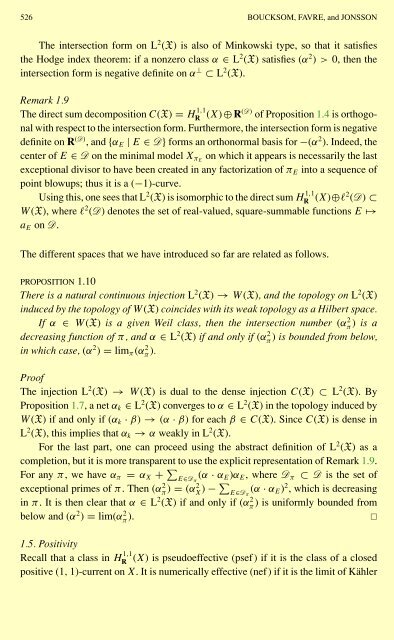A NULLSTELLENSATZ FOR AMOEBAS
A NULLSTELLENSATZ FOR AMOEBAS
A NULLSTELLENSATZ FOR AMOEBAS
Create successful ePaper yourself
Turn your PDF publications into a flip-book with our unique Google optimized e-Paper software.
526 BOUCKSOM, FAVRE, and JONSSON<br />
The intersection form on L 2 (X) is also of Minkowski type, so that it satisfies<br />
the Hodge index theorem: if a nonzero class α ∈ L 2 (X) satisfies (α 2 ) > 0, then the<br />
intersection form is negative definite on α ⊥ ⊂ L 2 (X).<br />
Remark 1.9<br />
The direct sum decomposition C(X) = H 1,1<br />
R<br />
(X) ⊕ R(D) of Proposition 1.4 is orthogonal<br />
with respect to the intersection form. Furthermore, the intersection form is negative<br />
definite on R (D) ,and{α E | E ∈ D} forms an orthonormal basis for −(α 2 ).Indeed,the<br />
center of E ∈ D on the minimal model X πE on which it appears is necessarily the last<br />
exceptional divisor to have been created in any factorization of π E into a sequence of<br />
point blowups; thus it is a (−1)-curve.<br />
Using this, one sees that L 2 (X) is isomorphic to the direct sum H 1,1<br />
R<br />
(X)⊕l2 (D) ⊂<br />
W (X), where l 2 (D) denotes the set of real-valued, square-summable functions E ↦→<br />
a E on D.<br />
The different spaces that we have introduced so far are related as follows.<br />
PROPOSITION 1.10<br />
There is a natural continuous injection L 2 (X) → W (X), and the topology on L 2 (X)<br />
induced by the topology of W (X) coincides with its weak topology as a Hilbert space.<br />
If α ∈ W (X) is a given Weil class, then the intersection number (απ 2 ) is a<br />
decreasing function of π, and α ∈ L 2 (X) if and only if (απ 2 ) is bounded from below,<br />
in which case, (α 2 ) = lim π (απ 2 ).<br />
Proof<br />
The injection L 2 (X) → W(X) is dual to the dense injection C(X) ⊂ L 2 (X). By<br />
Proposition 1.7,anetα k ∈ L 2 (X) converges to α ∈ L 2 (X) in the topology induced by<br />
W (X) if and only if (α k · β) → (α · β) for each β ∈ C(X). SinceC(X) is dense in<br />
L 2 (X), thisimpliesthatα k → α weakly in L 2 (X).<br />
For the last part, one can proceed using the abstract definition of L 2 (X) as a<br />
completion, but it is more transparent to use the explicit representation of Remark 1.9.<br />
For any π, wehaveα π = α X + ∑ E∈D π<br />
(α · α E )α E , where D π ⊂ D is the set of<br />
exceptional primes of π. Then(απ 2 ) = (α2 X ) − ∑ E∈D π<br />
(α · α E ) 2 , which is decreasing<br />
in π. It is then clear that α ∈ L 2 (X) if and only if (απ 2 ) is uniformly bounded from<br />
below and (α 2 ) = lim(απ 2 ).<br />
<br />
1.5. Positivity<br />
Recall that a class in H 1,1<br />
R<br />
(X) is pseudoeffective (psef) if it is the class of a closed<br />
positive (1, 1)-current on X. It is numerically effective (nef) if it is the limit of Kähler
















